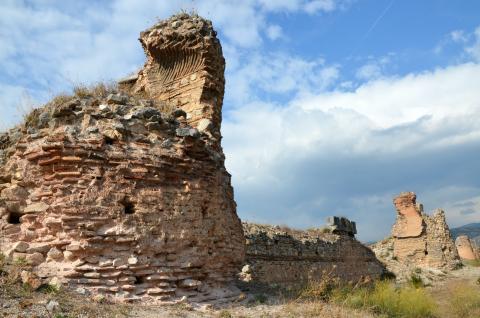The Siege of Nicaea
[2.7.2] Intereā pervēnimus ad Nīcēam, quae est caput tōtīus Romāniae, in quārtō diē, II nōnās Māiī, ibique castramētātī sumus. Priusquam autem Boamundus vēnisset ad nōs, tanta inopia pānis fuit inter nōs, ut ūnus pānis vēnderētur vīgintī aut trīgintā dēnāriīs. Postquam venit vir prūdēns Boamundus, iussit maximum mercātum condūcī per mare, et pariter utrimque veniēbant—ille per terram et ille per mare—et fuit maxima ūbertās in tōtā Chrīstī mīlitiā.
[2.8.1] In diē autem Ascēnsiōnis Dominī coepimus urbem circumquāque invādere, et aedificāre īnstrūmenta lignōrum atque turrēs ligneās, quō possēmus mūrālēs turrēs sternere. Tam fortiter et tam ācriter aggredimur urbem per duōs diēs, ut etiam foderēmus mūrum urbis. Turcī quippe quī erant in urbe, mīsērunt nūntiōs aliīs, quī vēnerant adiūtōrium cīvitātī dare, in hunc modum, quō audācter sēcūrēque approximent et per merīdiānam introeant portam, quoniam ex illā nēmō eīs erit obviam nec contrīstābit. Quae porta ipsā diē ā comite sānctī Egidīī in diē sabbatī post Ascēnsiōnem Dominī et epīscopō Podiēnsī hospitāta fuit. Quī comes, veniēns ex aliā parte, prōtectus dīvīnā virtūte ac terrēnīs fulgēbat armīs, cum suō fortissimō exercitū.
notes
vocabulary
2.8.1
circumquāque: on all sides (ML).
lignum lignī, n.: wood
sternō sternere strāvī strātum: to level, knock down (OLD 6)
quō: in order that (OLD 3)
fodiō, fodere, fōdī, fossum: to dig out, i.e., undermine
merīdiānus –a –um: southern
obviam: in the way, so as to meet (with dative, OLD 2b)
contristō (1): to sadden (CL); harm (ML)
hospitor (1): to put up as guest, to host (CL); to be occupied (ML)




